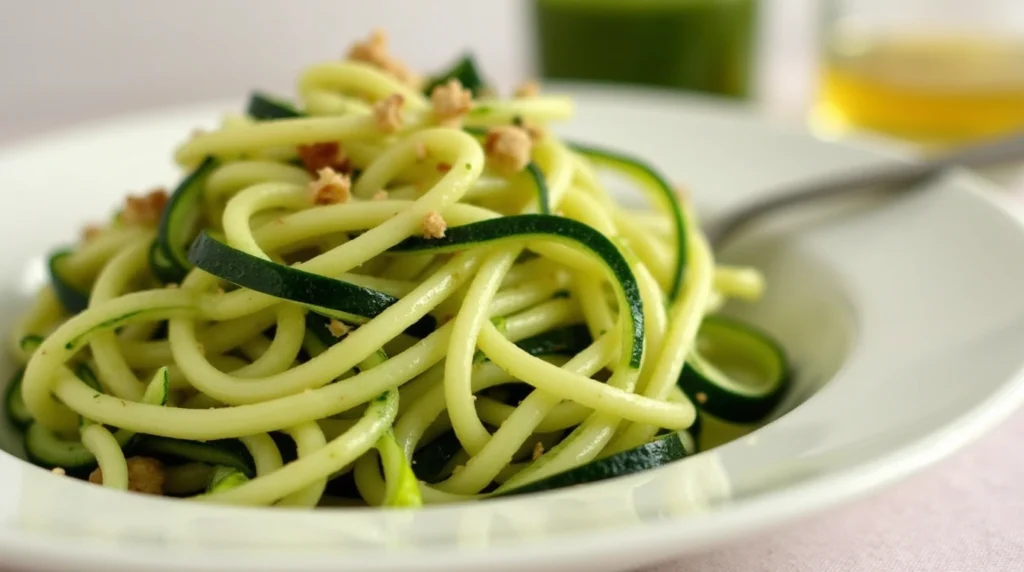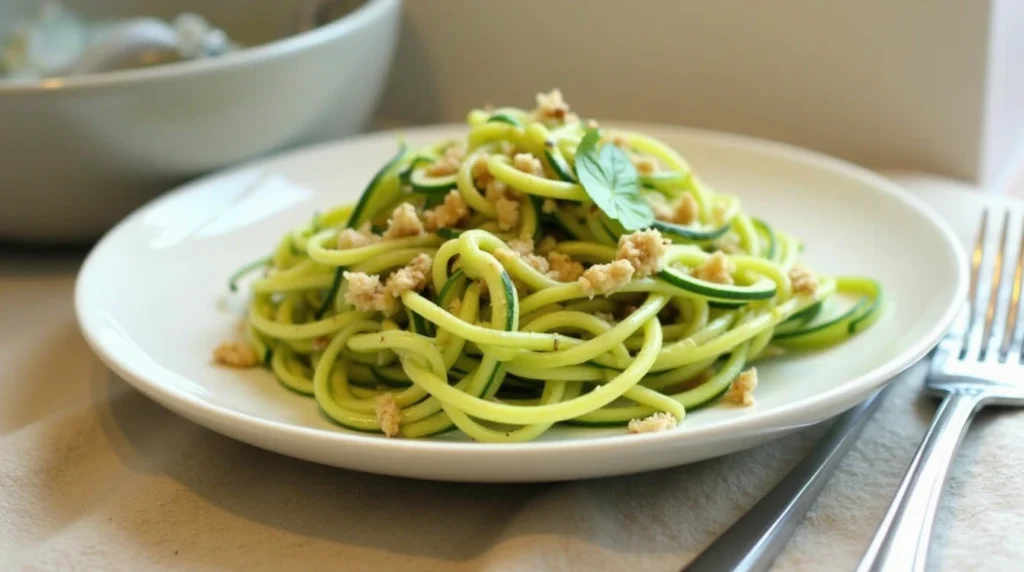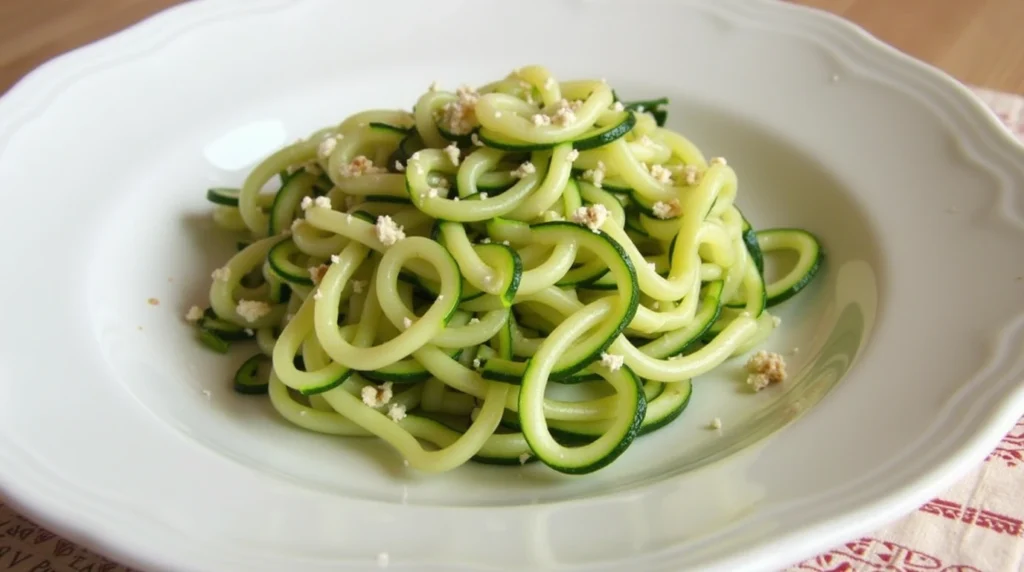Introduction

Zucchini Noodles Recipe, also known as “zoodles,” have become a beloved choice for those seeking a healthy, low-carb alternative to traditional pasta. If you’ve ever wondered what these green spirals are made of, you’re not alone! Whether you’re following a keto, gluten-free, or low-carb diet, zucchini noodles are an excellent way to enjoy a hearty meal without the guilt. They’re not only a great option for cutting down on carbs but also offer numerous health benefits, thanks to the nutritious power of zucchini.
So, what exactly are zucchini noodles made of? In this article, we’ll take a deep dive into everything you need to know about this trendy vegetable-based pasta alternative.
What Exactly Are Zucchini Noodles?
The Simple Ingredient Behind Zucchini Noodles
- Zucchini noodles are made from zucchini, a versatile summer squash that’s naturally low in carbs and high in water content.
- They’re typically spiralized into long, thin strips that resemble traditional pasta, creating the signature “zoodle” shape.
Why Zucchini Noodles Are Popular
- These noodles have gained popularity as a low-carb pasta alternative, making them ideal for those following keto, gluten-free, or paleo diets.
- Zucchini noodles provide a satisfying and nutritious option for those who want to enjoy a pasta-like texture without the heaviness of traditional noodles.
Texture and Appearance Compared to Traditional Pasta
- Zucchini noodles are lighter and have a crisp texture compared to regular pasta, making them a refreshing choice in hot weather or for light meals.
- Unlike regular pasta, which tends to absorb sauces and becomes soft, zucchini noodles maintain a firmer texture and can be enjoyed both raw and cooked.
How Are Zucchini Noodles Made?
Spiralizing Zucchini
- The most common method of making zucchini noodles is using a spiralizer, a kitchen tool that turns the zucchini into thin spirals.
- There are different spiralizer models, such as handheld versions or countertop units, but all work by turning the zucchini into a noodle-like shape.
- Tip: Choose firm, straight zucchinis for the best spiralizing results, as they produce long, consistent noodles.
Other Methods of Creating Zucchini Noodles
- Julienne Peeler: If you don’t have a spiralizer, a julienne peeler can create thinner strips, though the noodles will be slightly less uniform.
- Mandoline: A mandoline slicer can also be used to cut the zucchini into thin ribbons, though it requires more precision.
- Knife: For those without any specialized tools, simply slice the zucchini into thin strips with a knife, though this method may not create the perfect noodle shape.
Tips for Perfect Zucchini Noodles
- Prevent Sogginess: Zucchini has a high water content, which can cause your noodles to become soggy. To avoid this, salt the noodles after spiralizing and let them sit for 10 minutes to draw out excess moisture. Pat them dry before cooking.
- Don’t Overcook: Zucchini noodles cook quickly, so sauté or lightly steam them for no more than 2-3 minutes to maintain a pleasant texture.

Nutritional Benefits of Zucchini Noodles
Low in Carbs and Calories
- Zucchini noodles are an excellent option for those on low-carb and keto diets, with only 4 grams of carbs per cup.
- They are a much lighter option compared to traditional pasta, which can contain up to 40 grams of carbs per serving.
Rich in Nutrients
- Zucchini is packed with essential nutrients, including:
- Vitamin C: Supports the immune system.
- Potassium: Helps regulate blood pressure.
- Antioxidants: Protect the body from oxidative stress.
Gluten-Free and Paleo-Friendly
- Zucchini noodles are naturally gluten-free, making them a great choice for individuals with celiac disease or gluten sensitivities.
- They also fit into paleo diets, providing a clean, vegetable-based alternative to refined grain pasta.
Creative Recipes to Try with Zucchini Noodles
1– Zucchini Noodles with Pesto
- A light, fresh pesto made with basil, garlic, pine nuts, olive oil, and parmesan creates a vibrant sauce for your zoodles.
- Recipe: Toss the zucchini noodles with pesto, grilled chicken, or roasted vegetables for a satisfying meal.
2- Zucchini Noodles with Garlic and Olive Oil
- A simple yet flavorful dish made by sautéing zucchini noodles in olive oil with garlic, salt, and pepper.
- Recipe: Add some parmesan cheese on top for a quick, tasty meal that’s perfect for a weeknight dinner.
3- Zucchini Noodles Stir-Fry
- Stir-frying zucchini noodles with your favorite veggies (such as bell peppers, mushrooms, and carrots) and a splash of soy sauce or coconut aminos makes for a delicious stir-fry.
- Recipe: Toss in some shrimp or tofu for added protein and flavor.
Recipe Ingredients Table:
| Ingredient | Amount |
|---|---|
| Zucchini (spiralized) | 2 medium zucchinis |
| Olive oil | 2 tbsp |
| Garlic (minced) | 2 cloves |
| Parmesan cheese | 1/4 cup |
| Salt & Pepper | To taste |
Why Zucchini Noodles Are a Great Pasta Substitute
Low-Carb Pasta Alternative
- Zucchini noodles are a perfect low-carb substitute for traditional pasta, especially for those on keto diets.
- They offer a lighter alternative without sacrificing flavor or texture.
Versatility in Meals
- Zucchini noodles are incredibly versatile:
- Serve them cold in a salad with fresh veggies and dressing.
- Serve them warm as a side dish or in place of spaghetti in your favorite pasta recipes.
Healthier Choice
- When compared to traditional pasta, zucchini noodles are much lower in calories, carbs, and fats:
- Zucchini Noodles: 20 calories per cup, 4g carbs
- Spaghetti: 200 calories per cup, 42g carbs
How to Store Zucchini Noodles
Fresh Zucchini Noodles
- Zucchini noodles are best enjoyed immediately after preparation. However, if you need to store them, you can keep them in the refrigerator for up to 2-3 days.
- Store them in an airtight container to maintain freshness and prevent wilting.
- To keep them from becoming soggy, place a paper towel inside the container to absorb excess moisture.
Freezing Zucchini Noodles
- Zucchini noodles can be frozen if you want to keep them for a longer period.
- Blanching the noodles for 1-2 minutes in boiling water and then immediately placing them in an ice bath will help preserve their texture.
- After blanching, drain them well, pat them dry, and place them in freezer-safe bags or containers. They can be stored in the freezer for up to 3 months.
Thawing Frozen Zucchini Noodles
- To thaw frozen zucchini noodles, place them in the refrigerator overnight or defrost them in the microwave.
- You can also sauté frozen zucchini noodles directly in a pan for a quick and easy meal. Just be sure to remove any excess water before cooking.
Health Benefits of Zucchini Noodles
Promoting Digestive Health
- Zucchini is a great source of fiber, which is essential for digestive health. The high fiber content helps regulate bowel movements, preventing constipation, and promoting overall gut health.
Weight Management
- With zucchini noodles being low in calories and high in water content, they can keep you feeling full without the added calorie load of traditional pasta.
- Zucchini noodles are an excellent option for those aiming to maintain or lose weight.
Hydration
- Since zucchini is made up of 95% water, consuming zucchini noodles is a great way to stay hydrated, particularly in warmer months.
Supporting Heart Health
- Zucchini is also rich in potassium, a mineral that helps regulate blood pressure and supports heart health by balancing sodium levels in the body.

Zucchini Noodles vs. Traditional Pasta
Nutritional Comparison
| Nutrient | Zucchini Noodles (1 cup) | Traditional Spaghetti (1 cup) |
|---|---|---|
| Calories | 20 | 200 |
| Carbohydrates | 4g | 42g |
| Protein | 2g | 7g |
| Fiber | 1g | 2g |
| Fat | 0g | 1g |
- As shown in the table above, zucchini noodles are much lower in calories, carbs, and fat compared to traditional pasta. This makes them a fantastic choice for individuals trying to reduce their caloric intake or follow a low-carb or keto diet.
Taste and Texture Differences
- Zucchini noodles have a mild taste and can absorb flavors easily, making them adaptable to various sauces.
- Traditional pasta has a chewy, dense texture, while zucchini noodles have a more light and crispy texture, offering a fresh twist on traditional pasta dishes.
Popular Zucchini Noodles Recipes to Try
Zucchini Noodles with Creamy Avocado Sauce
- This recipe uses a creamy avocado sauce blended with garlic, lemon, and fresh herbs to create a smooth and rich topping for your zucchini noodles.
- Recipe: Blend ripe avocado with lemon juice, garlic, olive oil, and fresh basil, then toss it with zucchini noodles for a creamy, healthy alternative to traditional pasta sauces.
Zucchini Noodles with Bolognese Sauce
- A great low-carb alternative to spaghetti Bolognese, this recipe uses zucchini noodles paired with a meaty Bolognese sauce made with ground turkey or beef.
- Recipe: Make a classic Bolognese sauce by simmering tomatoes, ground meat, onions, garlic, and herbs. Serve over zucchini noodles for a hearty meal.
Zucchini Noodles with Shrimp and Lemon
- A light and refreshing dish, zucchini noodles pair perfectly with sautéed shrimp and a tangy lemon dressing.
- Recipe: Sauté shrimp with garlic and olive oil, toss with zucchini noodles, and finish with lemon juice and zest for a citrusy kick.
Recipe Ingredients Table:
| Ingredient | Amount |
|---|---|
| Zucchini (spiralized) | 2 medium zucchinis |
| Shrimp | 1 lb |
| Olive oil | 2 tbsp |
| Garlic (minced) | 2 cloves |
| Lemon juice | 2 tbsp |
| Lemon zest | 1 tsp |
| Salt & Pepper | To taste |
Common Mistakes to Avoid When Making Zucchini Noodles
Overcooking the Noodles
- Zucchini noodles cook quickly, and if you leave them on the stove for too long, they can become mushy. Avoid cooking them for more than 2-3 minutes to maintain their texture.
Using Wet Zucchini Noodles
- Zucchini has a high water content, which can lead to watery, soggy noodles if not properly drained. Always pat your noodles dry after spiralizing or use the salt method to draw out excess moisture.
Not Seasoning Properly
- Zucchini noodles have a mild flavor, so they require good seasoning to enhance their taste. Don’t forget to season them with salt, pepper, and herbs, or pair them with flavorful sauces to bring out the best in them.

How to Pair Zucchini Noodles with Sauces
Tomato-Based Sauces
- Zucchini noodles pair wonderfully with tomato-based sauces such as marinara or a simple roasted tomato sauce. The lightness of zucchini noodles allows the flavors of these classic pasta sauces to shine without feeling too heavy.
- Recipe Tip: Simmer your tomato sauce with garlic, basil, and a pinch of red pepper flakes for added flavor. Top with fresh Parmesan cheese for a delicious finish.
Creamy Sauces
- Zucchini noodles are an excellent match for creamy sauces, such as Alfredo or a creamy pesto. The freshness of the zucchini complements the richness of the sauce, making for a luxurious meal.
- Recipe Tip: Make a dairy-free creamy sauce using cashews blended with lemon juice, garlic, and nutritional yeast. This can serve as a vegan alternative to traditional Alfredo sauce.
Asian-Inspired Sauces
- For a unique twist, zucchini noodles can be paired with Asian-inspired sauces such as soy sauce, ginger, garlic, and sesame oil. This pairing works well for stir-fries, creating a flavorful and fresh dish.
- Recipe Tip: Sauté zucchini noodles with sautéed shrimp, bell peppers, and onions, then toss with a mixture of soy sauce, sesame oil, and a touch of honey for sweetness.
Zucchini Noodles for Meal Prep
Prepping Zucchini Noodles in Advance
- If you’re planning to prep meals for the week, zucchini noodles are easy to spiralize and store ahead of time. Simply store the noodles in an airtight container with a paper towel to absorb excess moisture.
- Tip: Make sure to prep the sauce separately and store it in a separate container. When you’re ready to eat, combine the noodles and sauce for a quick, fresh meal.
Meal Prep Recipe Ideas
- Zucchini Noodle Salad: Mix raw zucchini noodles with cherry tomatoes, avocado, and a light vinaigrette for a fresh, no-cook salad.
- Zucchini Noodles with Chicken: Prepare zucchini noodles with grilled chicken, pesto, and a sprinkle of Parmesan cheese for a protein-packed meal.
- Zucchini Noodles Stir-Fry: Pre-cook zucchini noodles in a stir-fry with lean protein (like tofu or chicken) and colorful vegetables for a complete, healthy meal.
Storing Meal Prep Zucchini Noodles
- To prevent zucchini noodles from becoming too watery when stored, avoid adding sauces or dressings until you’re ready to eat.
- You can store the noodles for up to 2-3 days in the fridge. If you’re planning to store them longer, consider freezing them after blanching.
Zucchini Noodles and Dietary Preferences
1- Zucchini Noodles for Keto and Low-Carb Diets
- Zucchini noodles are perfect for anyone following a keto or low-carb diet. They’re very low in carbs but still provide a satisfying texture that mimics traditional pasta.
- Why Zucchini Noodles Work: Zucchini noodles contain a fraction of the carbs found in regular pasta, which helps maintain ketosis or promote weight loss on low-carb diets.
2- Zucchini Noodles for Gluten-Free Diets
- Zucchini noodles are naturally gluten-free, making them an ideal pasta substitute for those with celiac disease or gluten sensitivity.
- Tip: Combine zucchini noodles with gluten-free sauces or toppings, such as a gluten-free marinara or homemade pesto.
3- Zucchini Noodles for Paleo Diets
- The paleo diet focuses on whole foods that are free from grains, legumes, and processed foods. Zucchini noodles fit perfectly into this lifestyle since they’re made from a whole vegetable and contain no added sugar or preservatives.
- Recipe Tip: Pair zucchini noodles with lean protein like grilled chicken or fish, fresh vegetables, and a simple olive oil dressing for a complete paleo-friendly meal.
Conclusion
Zucchini noodles are a fantastic, nutrient-packed alternative to traditional pasta, and they’re incredibly versatile. Whether you’re looking for a low-carb, gluten-free option or just want to incorporate more vegetables into your diet, zoodles are a great choice. Try making them at home and experiment with different recipes, like pesto zoodles or a simple garlic-olive oil dish. Ready to make the switch? Zucchini noodles might just become your new favorite meal!
FAQ Section
Q: What are zucchini noodles made of?
Zucchini noodles are made entirely from zucchini, which is spiralized or cut into long, thin strips to resemble pasta. They’re a healthy, low-carb, and gluten-free alternative to traditional pasta.
Q: Are zucchini noodles keto-friendly?
Yes! Zucchini noodles are an excellent choice for those following a keto diet since they are low in carbs and high in nutrients.
Q: How do you keep zucchini noodles from getting soggy?
To prevent sogginess, salt your zucchini noodles after spiralizing, let them sit for 10 minutes to draw out excess moisture, and pat them dry before cooking.
Q: Can zucchini noodles be eaten raw?
Absolutely! Zucchini noodles can be enjoyed raw in salads, or they can be lightly cooked by sautéing or steaming
